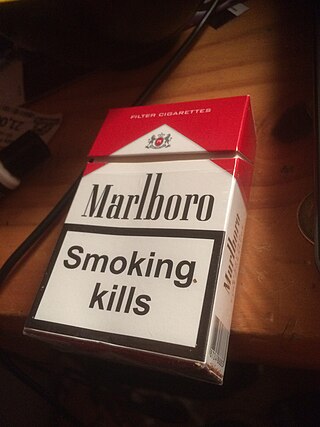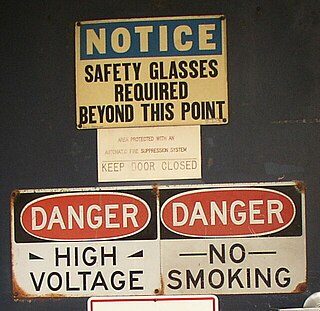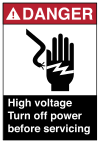
ISO 3864 specifies international standards for safety signs and markings in workplaces and public facilities. These labels are graphical, to overcome language barriers. The standard is split into four parts.

A biological hazard, or biohazard, is a biological substance that poses a threat to the health of living organisms, primarily humans. This could include a sample of a microorganism, virus or toxin that can adversely affect human health. A biohazard could also be a substance harmful to other living beings.

A hard hat is a type of helmet predominantly used in workplace environments such as industrial or construction sites to protect the head from injury due to falling objects, impact with other objects, debris, rain, and electric shock. Suspension bands inside the helmet spread the helmet's weight and the force of any impact over the top of the head. A suspension also provides space of approximately 30 mm between the helmet's shell and the wearer's head, so that if an object strikes the shell, the impact is less likely to be transmitted directly to the skull. Some helmet shells have a mid-line reinforcement ridge to improve impact resistance. The rock climbing helmet fulfills a very similar role in a different context and has a very similar design.

A steel-toe boot is a durable boot or shoe that has a protective reinforcement in the toe which protects the foot from falling objects or compression. Safety shoes are effective in keeping the feet of industrial workers safe from sharp and heavy objects while working in factories.

The Occupational Safety and Health Act of 1970 is a US labor law governing the federal law of occupational health and safety in the private sector and federal government in the United States. It was enacted by Congress in 1970 and was signed by President Richard Nixon on December 29, 1970. Its main goal is to ensure that employers provide employees with an environment free from recognized hazards, such as exposure to toxic chemicals, excessive noise levels, mechanical dangers, heat or cold stress, or unsanitary conditions. The Act created the Occupational Safety and Health Administration (OSHA) and the National Institute for Occupational Safety and Health (NIOSH).
Occupational noise is the amount of acoustic energy received by an employee's auditory system when they are working in the industry. Occupational noise, or industrial noise, is often a term used in occupational safety and health, as sustained exposure can cause permanent hearing damage. Occupational noise is considered an occupational hazard traditionally linked to loud industries such as ship-building, mining, railroad work, welding, and construction, but can be present in any workplace where hazardous noise is present.

A warning label is a label attached to a product, or contained in a product's instruction manual, warning the user about risks associated with its use, and may include restrictions by the manufacturer or seller on certain uses. Most of them are placed to limit civil liability in lawsuits against the item's manufacturer or seller. That sometimes results in labels which for some people seem to state the obvious.

The Globally Harmonized System of Classification and Labelling of Chemicals (GHS) is an internationally agreed-upon standard managed by the United Nations that was set up to replace the assortment of hazardous material classification and labelling schemes previously used around the world. Core elements of the GHS include standardized hazard testing criteria, universal warning pictograms, and safety data sheets which provide users of dangerous goods relevant information with consistent organization. The system acts as a complement to the UN numbered system of regulated hazardous material transport. Implementation is managed through the UN Secretariat. Although adoption has taken time, as of 2017, the system has been enacted to significant extents in most major countries of the world. This includes the European Union, which has implemented the United Nations' GHS into EU law as the CLP Regulation, and United States Occupational Safety and Health Administration standards.
Right to know is a human right enshrined in law in several countries. UNESCO defines it as the right for people to "participate in an informed way in decisions that affect them, while also holding governments and others accountable". It pursues universal access to information as essential foundation of inclusive knowledge societies. It is often defined in the context of the right for people to know about their potential exposure to environmental conditions or substances that may cause illness or injury, but it can also refer more generally to freedom of information or informed consent.
In United States safety standards, precautionary statements are sentences providing information on potential hazards and proper procedures. They are used in situations from consumer product on labels and manuals to descriptions of physical activities. Various methods are used to bring focus to them, such as setting apart from normal text, graphic icons, changes in text's font and color. Texts will often clarify the types of statements and their meanings within the text. Common precautionary statements are described below.
Effective safety training is an unofficial phrase used to describe the training materials designed to teach occupational safety and health standards developed by the United States government labor organization, Occupational Safety and Health Administration (OSHA). OSHA has produced many standards and regulations that affect employers and employees in the United States. United States employers have a legal responsibility to educate employees on all workplace safety standards and the hazards that their employees may face while on the job, and providing effective safety training meets that responsibility.
A safety management system (SMS) is a management system designed to manage occupational safety and health risks in the workplace. If the system contains elements elements of management of longer-term health impacts and occupational disease, it may be referred to as a safety and health management system (SHMS) or health and safety management system.
An occupational fatality is a death that occurs while a person is at work or performing work related tasks. Occupational fatalities are also commonly called "occupational deaths" or "work-related deaths/fatalities" and can occur in any industry or occupation.

A physical hazard is an agent, factor or circumstance that can cause harm with contact. They can be classified as type of occupational hazard or environmental hazard. Physical hazards include ergonomic hazards, radiation, heat and cold stress, vibration hazards, and noise hazards. Engineering controls are often used to mitigate physical hazards.

Barricade tape is brightly colored tape that is used to warn or catch the attention of passersby of an area or situation containing a possible hazard. It acts as a minor impediment to prevent accidental entrance to that area or situation and as a result enhances general safety. Barricade tape is also known as construction tape or barrier tape, or in reference to the safety hazard involved as caution tape, warning tape, danger tape or hazard tape. When used by police, the tape is named police tape.

Mr. Ouch is a hazard symbol developed by the US’s National Electrical Manufacturers Association (NEMA) to represent electrical hazard within pad-mounted transformers. Unlike other high-voltage warning symbols, Mr. Ouch was specifically designed with young children in mind. It is part of NEMA Standard 260-1996, Safety Labels for Pad-Mounted Switchgear and Transformers Sited in Public Areas, which lays out design guidelines for a complete label design that incorporates the Mr. Ouch symbol.

Workplace robotics safety is an aspect of occupational safety and health when robots are used in the workplace. This includes traditional industrial robots as well as emerging technologies such as drone aircraft and wearable robotic exoskeletons. Types of accidents include collisions, crushing, and injuries from mechanical parts. Hazard controls include physical barriers, good work practices, and proper maintenance.

Safety signs are a type of sign designed to warn of hazards, indicate mandatory actions or required use of Personal protective equipment, prohibit actions or objects, identify the location of firefighting or safety equipment, or marking of exit routes.
OSHliteracy or Occupational Safety and Health Literacy is the degree to which individuals have the functional capacity to access, process and utilize the Occupational Safety and Health (OSH) information and services needed to eliminate or reduce risk.

ANSI Z35.1 the Specifications for Accident Prevention Signs, was an American standard that dictated the layout, colors and wording of safety signs in the United States. The standard is the first American standard that made specific demands for the design, construction, and placement of safety signage in industrial environments. The first edition was published in January 1941, and the fourth and final edition in November 1972. Changes in societal needs of signage, and further research into signage would result in the establishment of a new committee, the ANSI Z535 Committee on Safety Signs and Colors, combining the separate committees of Z35.1 - Specifications for Accident Prevention Signs, Z35.2 - Specifications for Accident Prevention Tags, and Z53 - Marking Physical Hazards Safety Color Code, resulting in a new combined standard, ANSI Z535.















